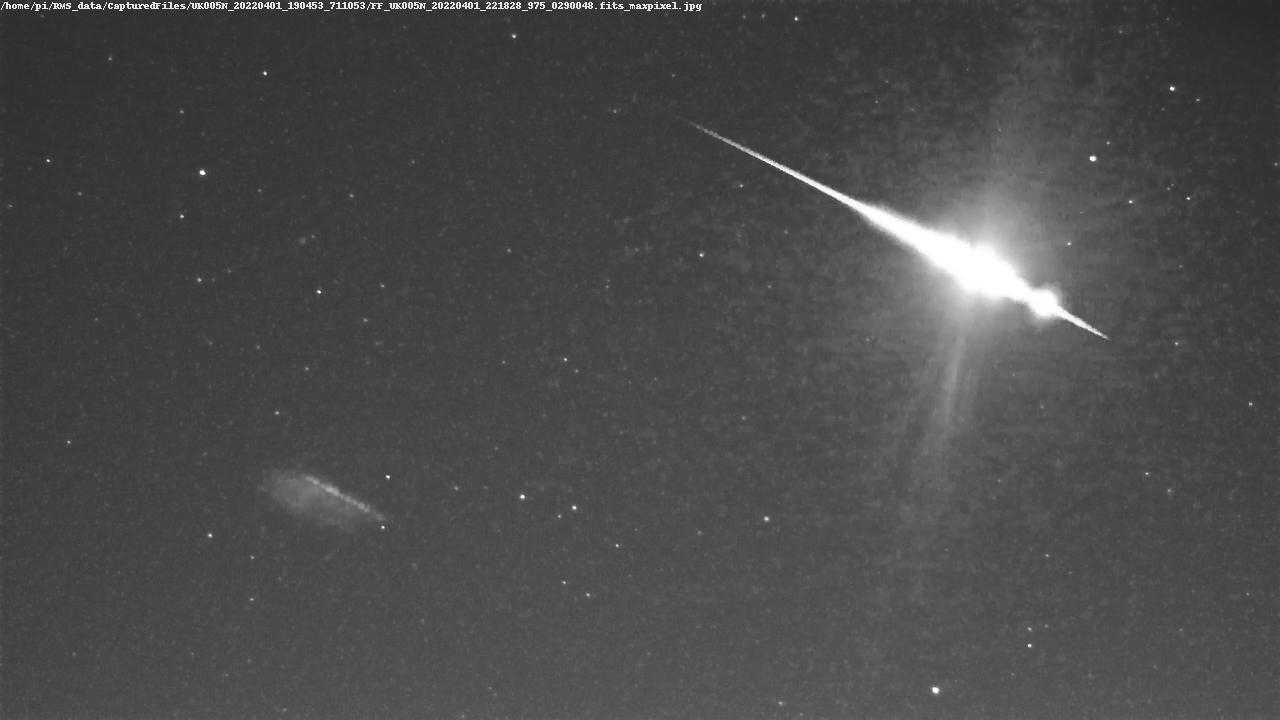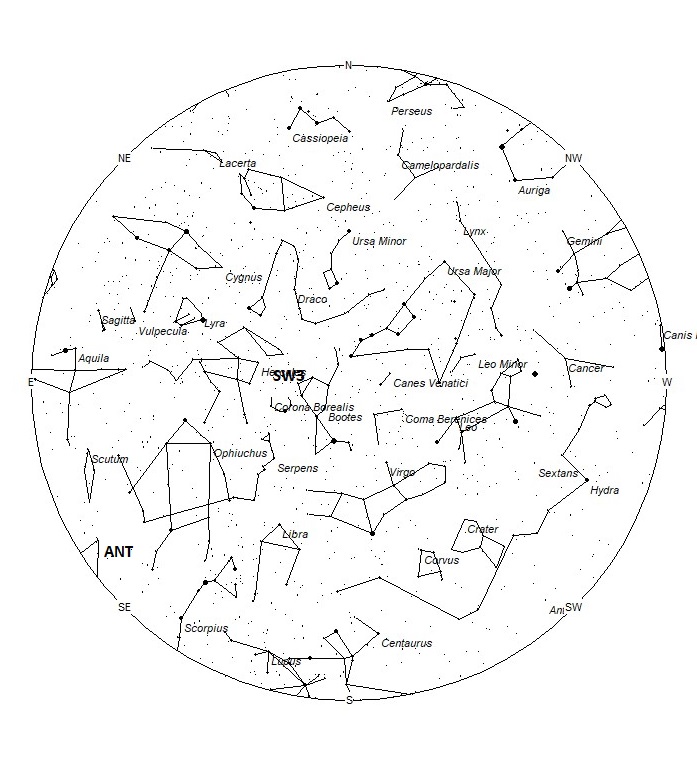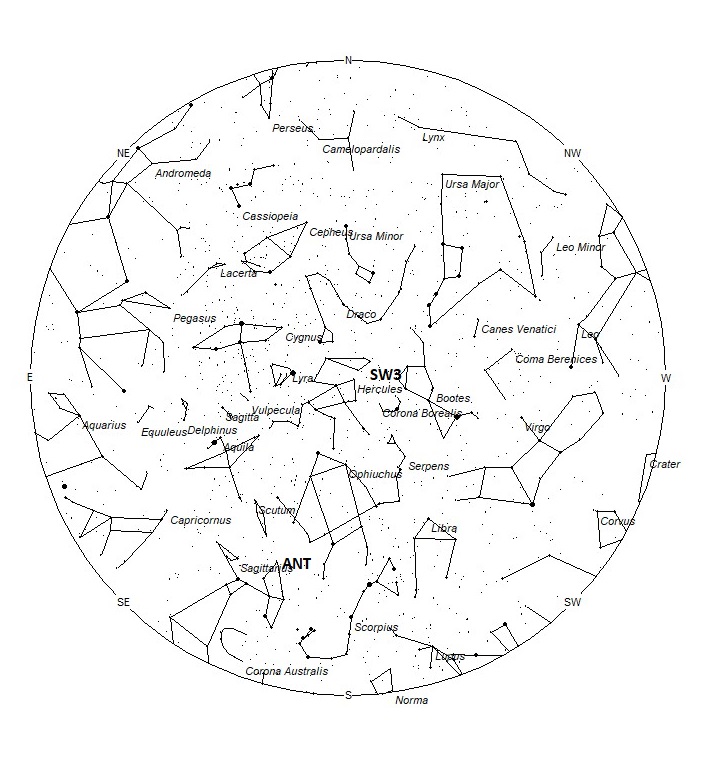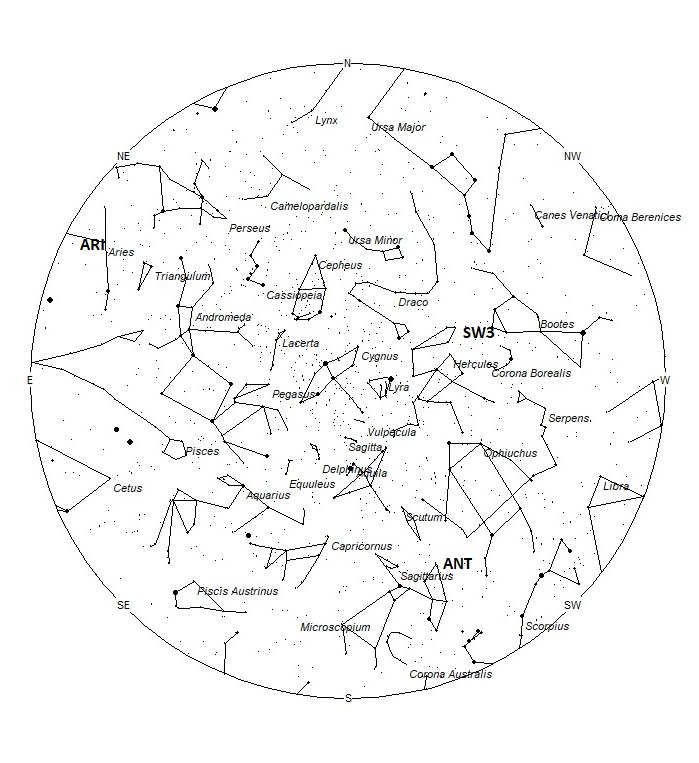 Peter Meadows captured this brilliant fireball on April 1 , 2022, at 20:18 BST (22:18 UT) from Chelmsford, England. The secondary image is an artifact caused by the extreme brightness of this fireball. For more information, photos, and videos on this fireball, visit the event page. ©Peter Meadows
Peter Meadows captured this brilliant fireball on April 1 , 2022, at 20:18 BST (22:18 UT) from Chelmsford, England. The secondary image is an artifact caused by the extreme brightness of this fireball. For more information, photos, and videos on this fireball, visit the event page. ©Peter MeadowsDuring this period, the moon reaches its first quarter phase on Tuesday June 7th. At that time the moon is located 90 degrees east of the sun and will set near 02:00 local daylight saving time (LDST). This weekend the waxing crescent moon will grace the evening sky but will set long before the more active morning hours arrive. For evening observers, the estimated total hourly rates should be near 2 as seen from mid-northern latitudes (45N) and 3 as seen from tropical southern locations (25S) For morning observers, the estimated total hourly rates should be near 7 as seen from mid-northern latitudes (45N) and 12 as seen from tropical southern locations (25S). Evening rates are reduced due to moonlight. The actual rates will also depend on factors such as personal light and motion perception, local weather conditions, alertness, and experience in watching meteor activity. Note that the hourly rates listed below are estimates as viewed from dark sky sites away from urban light sources. Observers viewing from urban areas will see less activity as only the brighter meteors will be visible from such locations.
The radiant (the area of the sky where meteors appear to shoot from) positions and rates listed below are exact for Saturday night/Sunday morning June 4/5. These positions do not change greatly day to day so the listed coordinates may be used during this entire period. Most star atlases (available at science stores and planetariums) will provide maps with grid lines of the celestial coordinates so that you may find out exactly where these positions are located in the sky. I have also included charts of the sky that display the radiant positions for evening, midnight, and morning. The center of each chart is the sky directly overhead at the appropriate hour. These charts are oriented for facing south but can be used for any direction by rotating the charts to the desired direction. A planisphere or computer planetarium program is also useful in showing the sky at any time of night on any date of the year. Activity from each radiant is best seen when it is positioned highest in the sky, either due north or south along the meridian, depending on your latitude. It must be remembered that meteor activity is rarely seen at the radiant position. Rather they shoot outwards from the radiant, so it is best to center your field of view so that the radiant lies at the edge and not the center. Viewing there will allow you to easily trace the path of each meteor back to the radiant (if it is a shower member) or in another direction if it is sporadic. Meteor activity is not seen from radiants that are located far below the horizon. The positions below are listed in a west to east manner in order of right ascension (celestial longitude). The positions listed first are located further west therefore are accessible earlier in the night while those listed further down the list rise later in the night.
These sources of meteoric activity are expected to be active this week.
.
Meteors from comet Schwassmann-Wachmann 3 (SW3) may still be visible during this period. This would be material that encounters the Earth on an annual basis, which is usually few and far between. The radiant is expected to be located near 15:22 (231) +39. This area of the sky is located in northern Corona Borealis, 2 degrees northeast of the 4th magnitude star known as Alkalurops (mu1 Bootis). This area of the sky is best placed between 2200-2300 LDST when it lies highest in the sky. Hourly rates are expected to be far less than 1. Note that this radiant is different than that of the recent outburst which was associated with debris released in 1995. With an entry velocity of 15 km/sec., the average meteor from this source would be very slow. These meteors are also known as the tau Herculids (TAH).
The large Anthelion (ANT) is currently centered at 17:48 (267) -23. This position lies in western Sagittarius, 5 degrees northeast of the 3rd magnitude star known as theta Ophiuchi. Due to the large size of this radiant, these meteors may also be seen from southern Ophiuchus as well as western Sagittarius. This radiant is best placed near 02:00 LDST when it lies on the meridian and is highest in the sky. Rates at this time should be near 2 per hour as seen from the Northern Hemisphere and 3 as seen from south of the equator. With an entry velocity of 30 km/sec., the average Anthelion meteor would be of slow velocity.
The Daytime Arietids (ARI) are active from May 29-June 17 with maximum activity occurring on June 4th. These meteors are difficult to catch as the radiant only lies 30 degrees west of the sun. Therefore, the only time these meteors are visible is during the last dark hour before dawn. The radiant is currently located at 02:48 (042) +24. This area of the sky is located in eastern Aries, 2 degrees south of the 4th magnitude star known as 41 Arietis. Current rates are expected to be less than 1 no matter your location. With an entry velocity of 40 km/sec., the average meteor from this source would be of medium velocity.
As seen from the mid-northern hemisphere (45N) one would expect to see approximately 6 sporadic meteors per hour during the last hour before dawn as seen from rural observing sites. Evening rates would be near 1 per hour. As seen from the tropical southern latitudes (25S), morning rates would be near 10 per hour as seen from rural observing sites and 2 per hour during the evening hours. Locations between these two extremes would see activity between the listed figures. Evening rates are reduced due to moonlight.
You can keep track of the activity of these meteor showers as well as those beyond the limits of visual observing by visiting the NASA Meteor Shower Portal available at: https://meteorshowers.seti.org/ You can move the sky globe to see different areas of the sky. Colored dots indicate shower meteors while white dots indicate sporadic (random) activity. The large orange disk indicates the position of the sun so little activity will be seen in that area of the sky.
The list below offers the information from above in tabular form. Rates and positions are exact for Saturday night/Sunday morning except where noted in the shower descriptions.
| SHOWER | DATE OF MAXIMUM ACTIVITY | CELESTIAL POSITION | ENTRY VELOCITY | CULMINATION | HOURLY RATE | CLASS |
| RA (RA in Deg.) DEC | (Geocentric) Km/Sec | Local Daylight Saving Time | North-South | |||
| Schwassmann-Wachmann 3 (SW3) | Jun 02 | 15:22 (231) +39 | 15 | 23:00 | <1 – <1 | III |
| Anthelions (ANT) | – | 17:48 (267) -23 | 30 | 02:00 | 1 – 2 | II |
| Daytime Arietids (ARI) | Jun 04 | 02:48 (042) +24 | 40 | 11:00 | <1 – <1 | IV |
 American Meteor Society
American Meteor Society



I live in North Peoria. I couldn’t sleep last night around 1:30AM I came to the back porch to look at the stars. As soon as I sat down I saw a huge shooting star or whatever it was! I’ve never seen it in 49 years of my life. It looked like fireworks at the end. It came down on an angle and exploded? It seemed close. I live against the dark desert near 303. Amazing experience!
I live in Central Wisconsin and around 3a.m. or 3:30a.m, I’m sitting outside and looked up for few seconds and just staring around and this meteorite or whatever it was appeared across the sky and there was long streak and big width of light for a second or two and dissappeared. It was badass! Never seen anything that huge of light going across the sky like that.
I live in Central Florida on the Gulf coast. Last night while gazing I saw this long wide streak of orange glow just as yours. I’ve never experienced anything like it before. It was huge and so bright…. Like just 1 streak of a firework but huge…. Dang it was perfect timing for my sight. I’m a seeker for night sky watching